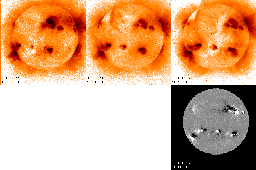 |
In the figure below, one can see the arcade, which develops in the northeast
quadrant of the Sun over the course of a couple of days. H-alpha images
(not shown here) show filaments in the region, one of which disappears
from a point directly along the line where the arcade begins to form. This,
and the location, suggest that the arcade is formed over a southerly excursion
of the polar crown neutral line. Although polar crown arcades are often
distorted, this one seems to be a severe case since it is at right angles
to the equator and extends south of the activity belt! What's going on?
 |
This development is actually not surprising at all, when one considers that we are in an early phase of the solar activity cycle. The current active latitudes are as close to the poles as they can be, and the distortion of the polar crown by the relatively intense fields of active regions and active region remnants is enhanced by their proximity. (In fact, one can argue that the polar crown is formed by the dispersal of such remnants.) The displayed magnetogram (courtesy of the Mt. Wilson Observatory web site ) is representative of the distribution of photospheric magnetic flux over the two day period, and shows that the decaying fields of the northern active region's "following" flux are still significant and that they abut the north polar crown region (whose fields are predominantly of the opposite polarity.) It is perhaps worthy of attention that the arcade first forms about halfway between this decaying system and that of the next remnant's oppositely polarized flux system.
Another item of note is the growth in girth of the arcade between the second and third day. The separation of the footpoints on the second day is consistent with the commonly accepted notions of arcade formation via filament eruption, but in the final image the system spans about half of a solar radius! We wonder if this is an example of a very slow, very long, very subdued LDE-type event, or are we seeing two separate phenomena: formation of an arcade by some "short" event, and subsequent evolution according to the global magnetic environment?